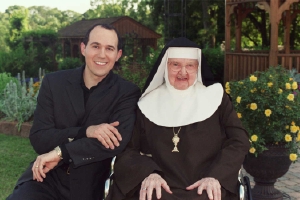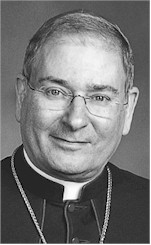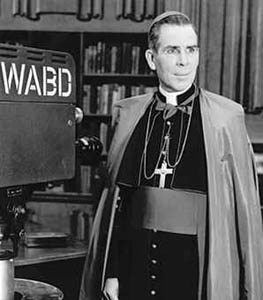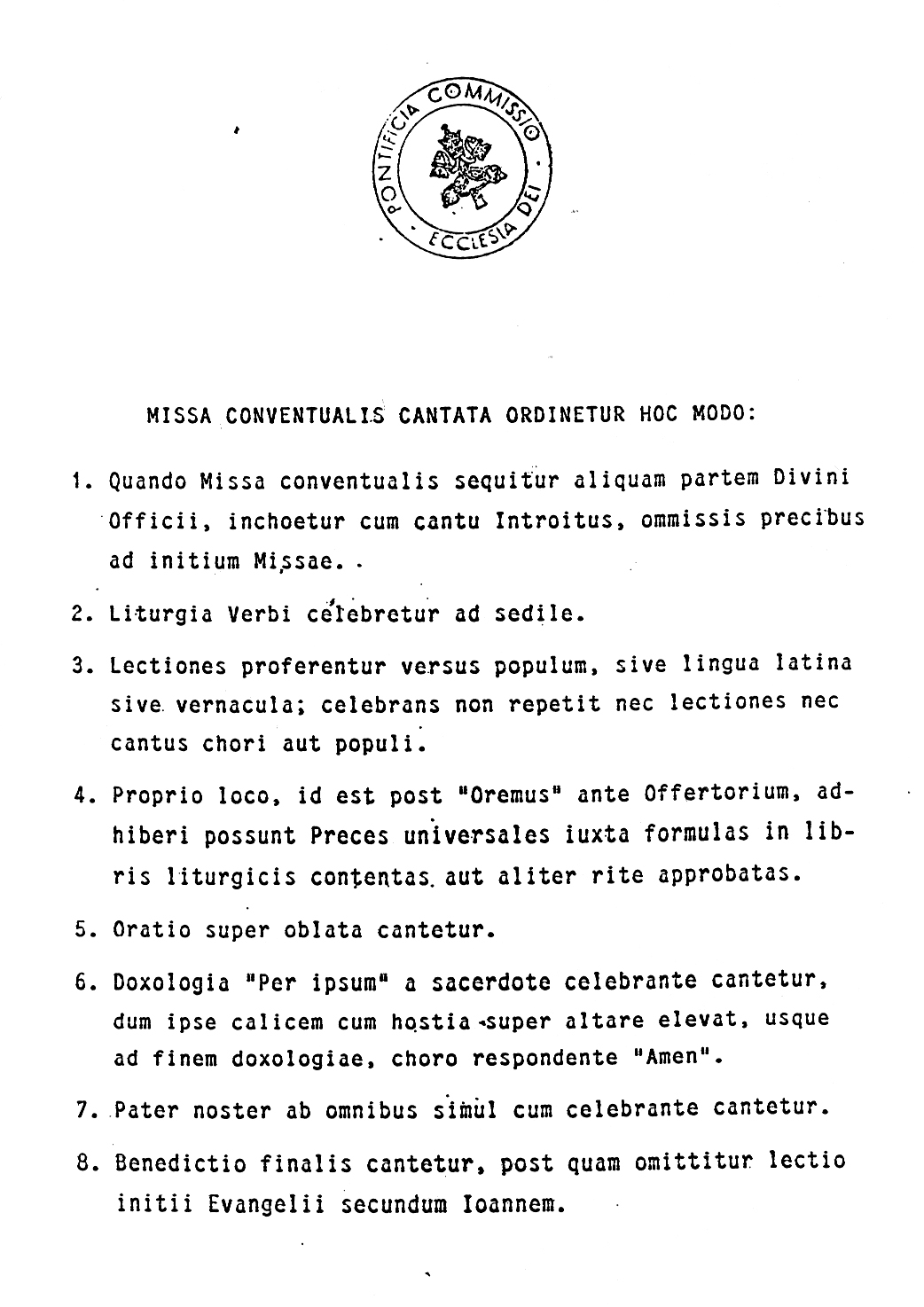CONGREGATION FOR THE DOCTRINE OF THE FAITH
RESPONSES TO SOME QUESTIONS REGARDING CERTAIN ASPECTSOF THE DOCTRINE ON THE CHURCH
Introduction
The Second Vatican Council, with its Dogmatic Constitution
Lumen gentium, and its Decrees on Ecumenism (
Unitatis redintegratio) and the Oriental Churches (
Orientalium Ecclesiarum), has contributed in a decisive way to the renewal of Catholic ecclesiolgy. The Supreme Pontiffs have also contributed to this renewal by offering their own insights and orientations for praxis: Paul VI in his Encyclical Letter
Ecclesiam suam (1964) and John Paul II in his Encyclical Letter
Ut unum sint (1995).
The consequent duty of theologians to expound with greater clarity the diverse aspects of ecclesiology has resulted in a flowering of writing in this field. In fact it has become evident that this theme is a most fruitful one which, however, has also at times required clarification by way of precise definition and correction, for instance in the declaration Mysterium Ecclesiae (1973), the Letter addressed to the Bishops of the Catholic Church
Communionis notio (1992), and the declaration
Dominus Iesus (2000), all published by the Congregation for the Doctrine of the Faith.
The vastness of the subject matter and the novelty of many of the themes involved continue to provoke theological reflection. Among the many new contributions to the field, some are not immune from erroneous interpretation which in turn give rise to confusion and doubt. A number of these interpretations have been referred to the attention of the Congregation for the Doctrine of the Faith. Given the universality of Catholic doctrine on the Church, the Congregation wishes to respond to these questions by clarifying the authentic meaning of some ecclesiological expressions used by the magisterium which are open to misunderstanding in the theological debate.
RESPONSES TO THE QUESTIONS
First Question: Did the Second Vatican Council change the Catholic doctrine on the Church?
Response: The Second Vatican Council neither changed nor intended to change this doctrine, rather it developed, deepened and more fully explained it.
This was exactly what John XXIII said at the beginning of the Council[1]. Paul VI affirmed it[2] and commented in the act of promulgating the Constitution
Lumen gentium: "There is no better comment to make than to say that this promulgation really changes nothing of the traditional doctrine. What Christ willed, we also will. What was, still is. What the Church has taught down through the centuries, we also teach. In simple terms that which was assumed, is now explicit; that which was uncertain, is now clarified; that which was meditated upon, discussed and sometimes argued over, is now put together in one clear formulation"[3]. The Bishops repeatedly expressed and fulfilled this intention[4].
Second Question: What is the meaning of the affirmation that the Church of Christ subsists in the Catholic Church?
Response: Christ "established here on earth" only one Church and instituted it as a "visible and spiritual community"[5], that from its beginning and throughout the centuries has always existed and will always exist, and in which alone are found all the elements that Christ himself instituted.[6] "This one Church of Christ, which we confess in the Creed as one, holy, catholic and apostolic […]. This Church, constituted and organised in this world as a society, subsists in the Catholic Church, governed by the successor of Peter and the Bishops in communion with him"[7].
In number 8 of the Dogmatic Constitution
Lumen gentium ‘subsistence’ means this perduring, historical continuity and the permanence of all the elements instituted by Christ in the Catholic Church[8], in which the Church of Christ is concretely found on this earth.
It is possible, according to Catholic doctrine, to affirm correctly that the Church of Christ is present and operative in the churches and ecclesial Communities not yet fully in communion with the Catholic Church, on account of the elements of sanctification and truth that are present in them.[9] Nevertheless, the word "subsists" can only be attributed to the Catholic Church alone precisely because it refers to the mark of unity that we profess in the symbols of the faith (I believe... in the "one" Church); and this "one" Church subsists in the Catholic Church.[10]
Third Question: Why was the expression "subsists in" adopted instead of the simple word "is"?
Response: The use of this expression, which indicates the full identity of the Church of Christ with the Catholic Church, does not change the doctrine on the Church. Rather, it comes from and brings out more clearly the fact that there are "numerous elements of sanctification and of truth" which are found outside her structure, but which "as gifts properly belonging to the Church of Christ, impel towards Catholic Unity"[11].
"It follows that these separated churches and Communities, though we believe they suffer from defects, are deprived neither of significance nor importance in the mystery of salvation. In fact the Spirit of Christ has not refrained from using them as instruments of salvation, whose value derives from that fullness of grace and of truth which has been entrusted to the Catholic Church"[12].
Fourth Question: Why does the Second Vatican Council use the term "Church" in reference to the oriental Churches separated from full communion with the Catholic Church?
Response: The Council wanted to adopt the traditional use of the term. "Because these Churches, although separated, have true sacraments and above all – because of the apostolic succession – the priesthood and the Eucharist, by means of which they remain linked to us by very close bonds"[13], they merit the title of "particular or local Churches"[14], and are called sister Churches of the particular Catholic Churches[15].
"It is through the celebration of the Eucharist of the Lord in each of these Churches that the Church of God is built up and grows in stature"[16]. However, since communion with the Catholic Church, the visible head of which is the Bishop of Rome and the Successor of Peter, is not some external complement to a particular Church but rather one of its internal constitutive principles, these venerable Christian communities lack something in their condition as particular churches[17].
On the other hand, because of the division between Christians, the fullness of universality, which is proper to the Church governed by the Successor of Peter and the Bishops in communion with him, is not fully realised in history[18].
Fifth Question: Why do the texts of the Council and those of the Magisterium since the Council not use the title of "Church" with regard to those Christian Communities born out of the Reformation of the sixteenth century?
Response: According to Catholic doctrine, these Communities do not enjoy apostolic succession in the sacrament of Orders, and are, therefore, deprived of a constitutive element of the Church. These ecclesial Communities which, specifically because of the absence of the sacramental priesthood, have not preserved the genuine and integral substance of the Eucharistic Mystery[19] cannot, according to Catholic doctrine, be called "Churches" in the proper sense[20].
The Supreme Pontiff Benedict XVI, at the Audience granted to the undersigned Cardinal Prefect of the Congregation for the Doctrine of the Faith, ratified and confirmed these Responses, adopted in the Plenary Session of the Congregation, and ordered their publication.
Rome, from the Offices of the Congregation for the Doctrine of the Faith, June 29, 2007, the Solemnity of the Holy Apostles Peter and Paul.
William Cardinal Levada
Prefect
Angelo Amato, S.D.B.
Titular Archbishop of Sila
Secretary
[1] JOHN XXIII, Address of 11 October 1962: "…The Council…wishes to transmit Catholic doctrine, whole and entire, without alteration or deviation…But in the circumstances of our times it is necessary that Christian doctrine in its entirety, and with nothing taken away from it, is accepted with renewed enthusiasm, and serene and tranquil adherence… it is necessary that the very same doctrine be understood more widely and more profoundly as all those who sincerely adhere to the Christian, Catholic and Apostolic faith strongly desire …it is necessary that this certain and immutable doctrine, to which is owed the obedience of faith, be explored and expounded in the manner required by our times. The deposit of faith itself and the truths contained in our venerable doctrine are one thing, but the manner in which they are annunciated is another, provided that the same fundamental sense and meaning is maintained" : AAS 54 [1962] 791-792.
[2] Cf. PAUL VI, Address of 29 September 1963: AAS 55 [1963] 847-852.
[3] PAUL VI, Address of 21 November 1964: AAS 56 [1964] 1009-1010.
[4] The Council wished to express the identity of the Church of Christ with the Catholic Church. This is clear from the discussions on the decree Unitatis redintegratio. The Schema of the Decree was proposed on the floor of the Council on 23.9.1964 with a Relatio (Act Syn III/II 296-344). The Secretariat for the Unity of Christians responded on 10.11.1964 to the suggestions sent by Bishops in the months that followed (Act Syn III/VII 11-49). Herewith are quoted four texts from this Expensio modorum concerning this first response.
A) [In Nr. 1 (Prooemium) Schema Decreti: Act Syn III/II 296, 3-6]
"Pag. 5, lin. 3-6: Videtur etiam Ecclesiam catholicam inter illas Communiones comprehendi, quod falsum esset.
R(espondetur): Hic tantum factum, prout ab omnibus conspicitur, describendum est. Postea clare affirmatur solam Ecclesiam catholicam esse veram Ecclesiam Christi" (Act Syn III/VII 12).
B) [In Caput I in genere: Act Syn III/II 297-301]
"4 - Expressius dicatur unam solam esse veram Ecclesiam Christi; hanc esse Catholicam Apostolicam Romanam; omnes debere inquirere, ut eam cognoscant et ingrediantur ad salutem obtinendam...
R(espondetur): In toto textu sufficienter effertur, quod postulatur. Ex altera parte non est tacendum etiam in aliis communitatibus christianis inveniri veritates revelatas et elementa ecclesialia"(Act Syn III/VII 15). Cf. also ibid pt. 5.
C) [In Caput I in genere: Act Syn III/II 296s]
"5 - Clarius dicendum esset veram Ecclesiam esse solam Ecclesiam catholicam romanam...
R(espondetur): Textus supponit doctrinam in constitutione ‘De Ecclesia’ expositam, ut pag. 5, lin. 24-25 affirmatur" (Act Syn III/VII 15). Thus the commission whose task it was to evaluate the responses to the Decree Unitatis redintegratio clearly expressed the identity of the Church of Christ with the Catholic Church and its unicity, and understood this doctrine to be founded in the Dogmatic Constitution Lumen gentium.
D) [In Nr. 2 Schema Decreti: Act Syn III/II 297s]
"Pag. 6, lin. 1- 24: Clarius exprimatur unicitas Ecclesiae. Non sufficit inculcare, ut in textu fit, unitatem Ecclesiae.
R(espondetur): a) Ex toto textu clare apparet identificatio Ecclesiae Christi cum Ecclesia catholica, quamvis, ut oportet, efferantur elementa ecclesialia aliarum communitatum".
"Pag. 7, lin. 5: Ecclesia a successoribus Apostolorum cum Petri successore capite gubernata (cf. novum textum ad pag. 6, lin.33-34) explicite dicitur ‘unicus Dei grex’ et lin. 13 ‘una et unica Dei Ecclesia’ " (Act Syn III/VII).
The two expressions quoted are those of Unitatis redintegratio 2.5 e 3.1.
[5] Cf. SECOND VATICAN COUNCIL, Dogmatic Constitution Lumen gentium, 8.1.
[6] Cf. SECOND VATICAN COUNCIL, Decree Unitatis redintegratio, 3.2; 3.4; 3.5; 4.6.
[7] SECOND VATICAN COUNCIL, Dogmatic Constitution, Lumen gentium, 8.2.
[8] Cf. CONGREGATION FOR THE DOCTRINE OF THE FAITH, Declaration Mysterium Ecclesiae, 1.1: AAS 65 [1973] 397; Declaration Dominus Iesus, 16.3: AAS 92 [2000-II] 757-758; Notification on the Book of Leonardo Boff, OFM, "Church: Charism and Power": AAS 77 [1985] 758-759.
[9] Cf. JOHN PAUL II, Encyclical Letter Ut unum sint, 11.3: AAS 87 [1995-II] 928.
[10] Cf. SECOND VATICAN COUNCIL, Dogmatic Constitution Lumen gentium, 8.2.
[11] SECOND VATICAN COUNCIL, Dogmatic Constitution Lumen gentium, 8.2.
[12] SECOND VATICAN COUNCIL, Decree Unitatis redintegratio, 3.4.
[13] SECOND VATICAN COUNCIL, Decree Unitatis redintegratio, 15.3; cf. CONGREGATION FOR THE DOCTRINE OF THE FAITH, Letter Communionis notio, 17.2: AAS, 85 [1993-II] 848.
[14] SECOND VATICAN COUNCIL, Decree Unitatis redintegratio, 14.1.
[15] Cf. SECOND VATICAN COUNCIL, Decree Unitatis redintegratio, 14.1; JOHN PAUL II, Encyclical Letter Ut unum sint, 56 f: AAS 87 [1995-II] 954 ff.
[16] SECOND VATICAN COUNCIL, Decree Unitatis redintegratio, 15.1.
[17] Cf. CONGREGATION FOR THE DOCTRINE OF THE FAITH, Letter Communionis notio, 17.3: AAS 85 [1993-II] 849.
[18] Ibid.
[19] Cf. SECOND VATICAN COUNCIL, Decree Unitatis redintegratio, 22.3.
[20] Cf. CONGREGATION FOR THE DOCTRINE OF THE FAITH, Declaration Dominus Iesus, 17.2: AAS 92 [2000-II] 758.








